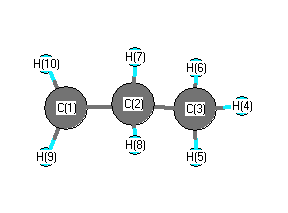Vibrational Frequencies calculated at QCISD(T)=FULL/cc-pVDZ
| Mode Number |
Symmetry |
Frequency
(cm-1) |
Scaled Frequency
(cm-1) |
IR Intensities
(km mol-1) |
Raman Act
(Å4/u) |
Dep P |
Dep U |
|---|
| 1 |
A |
3259 |
3125 |
|
|
|
|
| 2 |
A |
3150 |
3021 |
|
|
|
|
| 3 |
A |
3135 |
3006 |
|
|
|
|
| 4 |
A |
3129 |
3001 |
|
|
|
|
| 5 |
A |
3058 |
2933 |
|
|
|
|
| 6 |
A |
3045 |
2920 |
|
|
|
|
| 7 |
A |
2975 |
2853 |
|
|
|
|
| 8 |
A |
1497 |
1435 |
|
|
|
|
| 9 |
A |
1489 |
1428 |
|
|
|
|
| 10 |
A |
1467 |
1407 |
|
|
|
|
| 11 |
A |
1461 |
1401 |
|
|
|
|
| 12 |
A |
1409 |
1351 |
|
|
|
|
| 13 |
A |
1357 |
1302 |
|
|
|
|
| 14 |
A |
1268 |
1216 |
|
|
|
|
| 15 |
A |
1174 |
1126 |
|
|
|
|
| 16 |
A |
1103 |
1057 |
|
|
|
|
| 17 |
A |
1053 |
1010 |
|
|
|
|
| 18 |
A |
922 |
884 |
|
|
|
|
| 19 |
A |
891 |
854 |
|
|
|
|
| 20 |
A |
753 |
723 |
|
|
|
|
| 21 |
A |
462 |
443 |
|
|
|
|
| 22 |
A |
364 |
349 |
|
|
|
|
| 23 |
A |
263 |
252 |
|
|
|
|
| 24 |
A |
139 |
134 |
|
|
|
|
Unscaled Zero Point Vibrational Energy (zpe) 19411.3 cm
-1
Scaled (by 0.959) Zero Point Vibrational Energy (zpe) 18615.4 cm
-1
See section
III.C.1 List or set vibrational scaling factors
to change the scale factors used here.
See section
III.C.2
Calculate a vibrational scaling factor for a given set of molecules
to determine the least squares best scaling factor.
